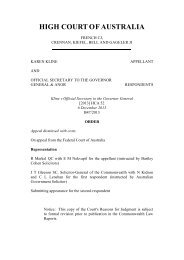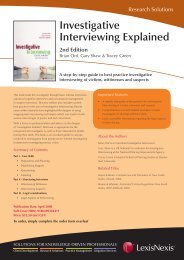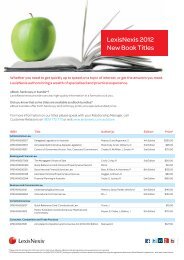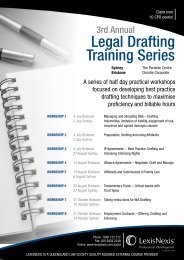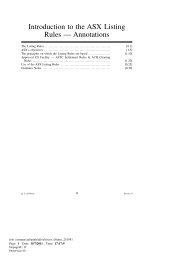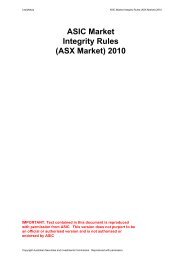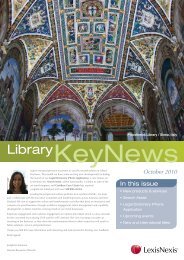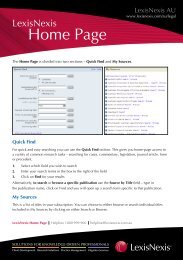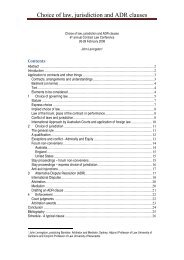Tenements and Titles - LexisNexis
Tenements and Titles - LexisNexis
Tenements and Titles - LexisNexis
You also want an ePaper? Increase the reach of your titles
YUMPU automatically turns print PDFs into web optimized ePapers that Google loves.
[130,210] ENERGY AND RESOURCES LAWJurisdictionTenementTasProspecting licenceExploration licenceSpecial exploration licenceDevelopment/retention phaseWestern Australia Retention licenceQueensl<strong>and</strong>Mineral development licenceNew South Wales Assessment leaseNorthern Territory Exploration retention licenceSouth Australia Retention leaseVictoriaNot applicableTasmaniaRetention licenceProduction phaseWestern Australia Mining leaseGeneral purpose leaseQueensl<strong>and</strong>Mining claim (for minerals other than coal)Mining leaseNew South Wales Mineral claimMining leaseNorthern Territory Mining claimMineral leaseExtractive mineral lease (mining of soil, s<strong>and</strong>, gravel clay, stoneused in ceramics manufacture or construction)Extractive mineral permitSouth Australia Mineral claimMining leasePrecious stones claim (opal)Opal development leaseVictoriaMining licenceTasmaniaMining leaseHOW TO APPLY[130,410] Introductory commentsIn each state <strong>and</strong> territory, except for parts of NSW, minerals are the property of theCrown in right of the state or territory. In NSW, for historical reasons, some minerals arestill privately owned. Each state <strong>and</strong> territory has its own mining legislation whichregulates the application for <strong>and</strong> obtaining of mineral tenements.However, even in NSW, all prospecting <strong>and</strong> mining for minerals prescribed by theregulations, whether privately or publicly owned, now require an authorisation under theMining Act 1992 (NSW). Prior to 15 November 2010, certain areas were held underPrivate Mining Agreements (PMAs) under the provisions of the Mining Act 1992 (NSW).These provisions were repealed following the commencement of the Mining AmendmentAct 2008 (NSW). Savings provisions allow PMAs to continue for a period of 12 monthsfrom 15 November 2010 to allow the mineral owner to apply for an authorisation tocontinue their operations.Service 0 130,102 <strong>LexisNexis</strong>Job: research/erl/allvols/serv_0/chapter_5_262680Page: 8 Date: 11/8/2011 Time: 15:30:3bwpageid:: 130102::bwservice::0::
TENEMENTS AND TITLES[130,810]An ML application is only considered by a warden if an objection has been lodged toit <strong>and</strong> not withdrawn.Only the minister may award an ML, regardless of whether a warden has recommendedthe grant or refusal of the ML. If the ML application is accompanied by a statement <strong>and</strong>a mineralisation report, the minister cannot grant the application if the Director,Geological Survey’s report states there is no significant mineralisation.There is no appeal from the minister’s decision to grant or refuse an ML, except forjudicial review of an administrative action.Special purpose licence (SPL)A statement must accompany the application to include either a development <strong>and</strong>construction proposal or a statement setting out specific intentions for the SPL.General purpose lease (GPL)The minister may, following a recommendation by the warden or mining registrar,grant a GPL to be used with respect to mining operations on such terms <strong>and</strong> conditions asthe minister considers reasonable. The maximum area is 10 hectares unless the ministerconsiders that a larger area is required.Miscellaneous licenceThe general provisions above, apply to the application for a miscellaneous licence. Thearea of a miscellaneous licence must be marked out. There is no limit to the number oflicences a person or company may hold.Notes1 See s 41(1) for a PL or SPL; see s 58(1) for an EL; see s 74 for ML.5 See s 58(3) for ELs, s 41(3) for PLs <strong>and</strong> SPLs.10 To define the area of an EL, the l<strong>and</strong> of Western Australia is divided into “blocks”.[130,810] Queensl<strong>and</strong>General criteria applicable to all applications (unless specified otherwise)The licence instrument contains all the key terms <strong>and</strong> conditions, however, a licenceholder must also comply with the Mineral Resources Act 1989 (Qld) (the MRA).A licence is applied for by lodging the prescribed forms, paying the prescribed rent <strong>and</strong>application fee <strong>and</strong> generally including the applicant(s) address details, specifying theminerals in respect of which the licence is sought, identifying the l<strong>and</strong> over which thelicence is sought (including the boundaries), specifying the technical <strong>and</strong> financialresources available to the applicant(s) <strong>and</strong> including a description of the proposed workprogram.A licence under the MRA may only be granted to an “eligible person”. An eligibleperson includes an adult, a company, a local government area <strong>and</strong> an educationalinstitution.Prospecting permit (PP)A PP may only be issued in the name of a single eligible person.In addition to the general requirements above, the application for a parcel PP must beaccompanied by a sketch <strong>and</strong> description (or other acceptable means) of the l<strong>and</strong> overwhich the PP is sought <strong>and</strong> include the name <strong>and</strong> address of each owner <strong>and</strong> occupier overwhich the parcel PP <strong>and</strong> any access routes is proposed.<strong>LexisNexis</strong> 130,105Service 0Job: research/erl/allvols/serv_0/chapter_5_262680Page: 11 Date: 11/8/2011 Time: 15:30:3bwpageid:: 130105::bwservice::0::
[130,810] ENERGY AND RESOURCES LAWMining claim (claim)A person may only apply for a claim over l<strong>and</strong> already held by that person under anexisting prospecting permit (PP).A mining claim may be granted in respect of any specified minerals except for coal.The area <strong>and</strong> shape of a claim must conform to certain specifications.A person may not, at any time, have a direct or indirect interest in more than twoclaims.Before applying for a claim, it must be marked out in the prescribed manner <strong>and</strong> theapplication for a claim must be lodged within 5 days of its marking out.Exploration permit (EP)In addition to the general criteria applicable to all licence applications, an applicant foran EP must also include: details of exploration data already captured by the applicant inrelation to that l<strong>and</strong>; <strong>and</strong> the resources proposed to be committed to the exploration work.A person may not apply for an EP within 2 months of that l<strong>and</strong> ceasing to be subjectto an EP.Mineral Development licence (MDL)Only a current holder of an exploration permit (EP) or a mining lease (ML) may applyfor an MDL in respect of l<strong>and</strong> that comprises the EP or an ML.In addition to the general criteria applicable to all licence applications, a statement mustbe included with the application giving detailed description <strong>and</strong> technical particulars ofthe mineral occurrence the subject of the application <strong>and</strong> the resources proposed to becommitted to the work program.Mining lease (ML)Unless otherwise approved by the minister, only current holders of an explorationpermit (EP), prospecting permit (PP), or mineral development licence (MDL) may applyfor a ML in respect of the mineral for which the licence is held.In addition to the general criteria applicable to all licence applications, before lodgingan application for an ML, the proposed area of the ML must be marked out in accordancewith the Mineral Resources Act 1989 (Qld) (the MRA), <strong>and</strong> the application for an MLmust be lodged within 5 days of the marking out.Included in the application must also be the proposed term of the ML, a statement(acceptable to the mining registrar) outlining the proposed mining program, its method ofoperation, estimating when operations will start, if a mining program is not proposed,outlining the use proposed for the l<strong>and</strong> <strong>and</strong> the commencement date <strong>and</strong> the proposedinfrastructure.Before a ML is granted, the applicant must agree to compensate l<strong>and</strong>owners.The minister may, at their discretion, <strong>and</strong> incompliance with the MRA, grant or refuseto grant an ML.[131,010] New South WalesCommon terms for applying for or grant of tenementsAll tenements under the regime in NSW are granted at the discretion of the minister <strong>and</strong>cannot be granted over l<strong>and</strong> that is already the subject of a tenement for that specificmineral without the written consent of the holder/applicant of that prior tenement.Service 0 130,106 <strong>LexisNexis</strong>Job: research/erl/allvols/serv_0/chapter_5_262680Page: 12 Date: 11/8/2011 Time: 15:30:3bwpageid:: 130106::bwservice::0::
TENEMENTS AND TITLES[131,010]The Mining Act 1992 (NSW) (the Mining Act), which governs the grant of miningtenements in NSW, also limits the holders of tenements from starting prospectingoperations in an “exempted area” without first obtaining the minister’s written consent.An “exempted area” under the Mining Act are l<strong>and</strong>s set aside for public purposes, such astravelling stock reserves, road reserves, water supply reserves, state forests, publicreserves <strong>and</strong> permanent corridors.The governor may also constitute any l<strong>and</strong> as a minerals allocation area for all minerals,for specified minerals <strong>and</strong> more than one mineral allocation area may be specified inrespect of the same l<strong>and</strong>.Without the minister’s consent, a person may not apply for a tenement in respect ofl<strong>and</strong> for 2 years after the cancellation or refusal of that tenement over that l<strong>and</strong>.The applicant for a tenement must arrange for notice of the application to be publishedin a newspaper generally circulating in NSW within 14 days of lodging the application.Exploration licence (EL)Any person may apply for an EL.The minister’s consent is required before applying for an EL in respect of a mineral inan allocated mineral in a minerals allocation area.The EL application must specify the minerals to be explored <strong>and</strong> be accompanied bythe required information <strong>and</strong> fee. Information to be included in an application includes adescription of the l<strong>and</strong>, details of available financial <strong>and</strong> technical resources, details of theproposed program of work, the proposed amount of expenditure.The minister may also invite tenders for the grant of ELs in relation to minerals in aminerals allocation area.The decision-maker may in their discretion either grant or refuse to grant the EL.Assessment lease (AL)Unless already subject to an existing tenement, any person may apply for an AL.The minister’s consent is required before applying for an AL in respect of an allocatedmineral in a minerals allocation area, unless the applicant already holds an explorationlicence (EL) or mining lease (ML) in respect of that mineral over that l<strong>and</strong>.The AL application must include the same information required for the EL application,except that in addition to that information, an AL application must also include anassessment of the mineral bearing capacity of l<strong>and</strong> the subject of the application <strong>and</strong> theextent of any mineral deposits on that l<strong>and</strong> <strong>and</strong> details of any proposed marketing programor environmental study.The decision maker of the AL application may exclude l<strong>and</strong> from assessment in the ALapplication.The decision maker has discretion, in accordance with the Mining Act, to grant or torefuse to grant an AL application.Mining lease (ML)Any person may apply for a ML.The minister’s consent is required before applying for an ML in respect of an allocatedmineral in a minerals allocation area, unless the applicant already holds an explorationlicence (EL) or assessment lease (AL) in respect of that mineral over that l<strong>and</strong>. If notenement exists in that area, the minister may call for tenders for people to apply for theML.The ML application must include the same information required for an EL application,<strong>LexisNexis</strong> 130,107Service 0Job: research/erl/allvols/serv_0/chapter_5_262680Page: 13 Date: 11/8/2011 Time: 15:30:3bwpageid:: 130107::bwservice::0::
[131,010] ENERGY AND RESOURCES LAWexcept that in addition to that information, an ML application must also include anassessment of the mineral bearing capacity of l<strong>and</strong> the subject of the application <strong>and</strong> theextent of any mineral deposits on that l<strong>and</strong>.Compliance with the public consultation process is required before a ML can begranted.The minister has discretion whether or not to grant the ML.Opal prospecting licence (OPL)An OPL can only be granted over l<strong>and</strong>s defined as an “opal prospecting block” withinan area designated under the Mining Act 1992 (NSW) as an “opal prospecting area”.Any person may apply for an OPL over an opal prospecting block by lodging anapplication in writing with the Director-General attaching: the fee prescribed byregulations <strong>and</strong> any information prescribed by regulations.If more than one application is lodged in respect of the same opal prospecting block,the applications are to be dealt with in the order in which they were lodged, or if they werelodged simultaneously, as prescribed by regulation.An OPL may be granted or refused in the Director-General’s discretion.Mining claim (claim)The Mining Act 1992 (NSW) makes provision for the creation of Mineral ClaimsDistricts (MCD). Special conditions approved by the minister <strong>and</strong> advertised in theGovernment Gazette apply to mineral claims granted over l<strong>and</strong> within a district.In addition to the requirements above, before applying for a claim, a person must first:• mark out the area of l<strong>and</strong> the subject of the claim application <strong>and</strong> prepare a planof the area; <strong>and</strong>• notify all affected l<strong>and</strong>holders.A claim may be granted or refused in the discretion of the Director-General.RIGHTS AND OBLIGATIONS[132,010] Introductory commentsThe rights <strong>and</strong> obligations of tenement holders under their respective tenements arefound in two sources:• the relevant state or territorial mining legislation <strong>and</strong> regulations; <strong>and</strong>• the instrument granting the tenement.All mining legislation requires that the tenement holder comply with both theinstrument granting tenement <strong>and</strong> applicable provisions of the legislation. Further, moststate <strong>and</strong> territorial legislation contains general rights <strong>and</strong> obligations, to which eachtenement holder, regardless of which tenement is held, has the benefit of <strong>and</strong> is subject to,<strong>and</strong> rights <strong>and</strong> obligations that are specific to the tenement granted.[132,210] Western AustraliaGeneral rights <strong>and</strong> obligationsWhen carrying out activities under licence a licence holder must:• promptly report the discovery of all minerals of economic interest;• not use ground disturbing equipment unless the minister or other official hasapproved that work program in writing;Service 0 130,108 <strong>LexisNexis</strong>Job: research/erl/allvols/serv_0/chapter_5_262680Page: 14 Date: 11/8/2011 Time: 15:30:3bwpageid:: 130108::bwservice::0::
TENEMENTS AND TITLES[132,210]• fill in or render safe all holes, pits, trenches <strong>and</strong> other disturbances to the l<strong>and</strong>made while prospecting which would likely endanger an animal or person;• take all necessary steps to prevent fire, damage to trees <strong>and</strong> other property <strong>and</strong> toprevent damage to any property or damage to livestock;• comply with any other conditions imposed by the licence grant instrument; <strong>and</strong>• comply with the minimum expenditure <strong>and</strong> work program conditions in thelicenceProspecting licence (PL)A PL holder may, subject to the licence conditions:• enter <strong>and</strong> re-enter the l<strong>and</strong> the subject of the PL, as necessary• prospect, subject to the licence conditions, including digging pit;s, trenches <strong>and</strong>holes, <strong>and</strong> sinking bores <strong>and</strong> tunnels to the extent necessary;• or disturb up to 500 tonnes of material from the ground, including overburden;the minister may approve extraction of larger tonnages;• to apply for, <strong>and</strong>, subject to the Mining Act 1978 (WA), have granted to it one ormore mining or general purpose leases.Special prospecting licence (SPL)A SPL holder may:• prospect for gold only;• remove up to 50 tonnes of material, without special ministerial approval;• carry out activities to the following depths:— 50m if not specified; or— negotiated between a holder of a special prospecting licence <strong>and</strong> theunderlying primary tenement holder to a depth which is less than 50mbelow the surface; or— the minister may agree to a depth that is greater than 50m.If the primary tenement is forfeited, expires or is surrendered before the SPL, the SPLbecomes a normal prospecting licence with no depth restriction on activities.An SPL holder is subject to the same obligations as a prospecting licence (PL) holder(including the general obligations).Exploration licence (EL)A EL holder is authorised to:• enter the l<strong>and</strong> for the purposes of exploration for minerals with employees,contractors <strong>and</strong> such vehicles, equipment <strong>and</strong> machinery as may be necessary;• excavate, extract or remove earth, soil, rock, stone fluid or mineral bearingsubstances not exceeding 1,000 tonnes over the term of the licence, or suchgreater tonnage approved by the Minister.An EL holder must comply with the general obligations set out above.Retention licence (RL)A RL holder is authorised to carry out the same work as the holder of an explorationlicence (EL). It is “holding” title for a mineral resource that has been identified but is notable to be further explored or mined.Mining licence (ML)The holder of a ML is permitted, subject to the licence conditions <strong>and</strong> the MiningAct 1978 (WA), to work <strong>and</strong> mine the l<strong>and</strong>, take <strong>and</strong> remove any minerals (except for iron<strong>LexisNexis</strong> 130,109Service 0Job: research/erl/allvols/serv_0/chapter_5_262680Page: 15 Date: 11/8/2011 Time: 15:30:3bwpageid:: 130109::bwservice::0::
[132,210] ENERGY AND RESOURCES LAWore, unless expressly authorised) <strong>and</strong> dispose of them, take <strong>and</strong> divert water subject to therights in Water <strong>and</strong> Irrigation Act 1914 (WA), <strong>and</strong> do all things necessary to effectivelycarry out mining operations in, on or under the l<strong>and</strong>. Note, that further approvals aregenerally required before production of minerals may start, including approvals in respectof environmental impact.Special purpose leaseA SPL is for purposes directly connected with mining operations such as operatingmachinery, depositing or treating tailings or for prescribed purposes.General purpose lease (GPL)A GPL entitles its holder, <strong>and</strong> their agents <strong>and</strong> employees, to the exclusive occupationof the l<strong>and</strong> for one or more permitted purposes. These include erecting, placing <strong>and</strong>operating machinery in connection with mining operations, depositing or treating ofminerals or tailings <strong>and</strong> use of l<strong>and</strong> for any other specified purpose directly connectedwith mining operations.St<strong>and</strong>ard conditions include the requirement to pay rent, to use the l<strong>and</strong> only for thespecified purpose, to lodge periodical reports <strong>and</strong> to report any significant discovery ofminerals.An application for a GPL is determined in the same manner as for a mininglicence(ML).Miscellaneous licenceA miscellaneous licence is for purposes such as a road, pipeline, water, as prescribed inthe regulations.[132,410] Queensl<strong>and</strong>Common rights <strong>and</strong> obligationsEach tenement requires its holders to:• carry out improvement restoration to the tenement area (<strong>and</strong> if necessary, removeall equipment <strong>and</strong> plant on the l<strong>and</strong> the subject of a tenement;• (if required) pay royalty, rent, security;• use the l<strong>and</strong> for the purpose for which the tenement was granted in accordancewith the conditions of the tenement <strong>and</strong> the MRA;• lodge reports <strong>and</strong> give all information (as required).Prospecting Permit (PP)A PP entitles the holder to prospect for <strong>and</strong>/or h<strong>and</strong>-mine for minerals (excluding coal)<strong>and</strong>/or peg a mining lease or mining claim on the available l<strong>and</strong> specified.There are two types of prospecting permits:• a parcel prospecting permit can be granted for a particular parcel for a term of3 months;• a district prospecting permit:— can be granted for all available l<strong>and</strong> within a mining district for a term of1–12 months;— is subject to the holder obtaining the written consent of the l<strong>and</strong> owner foraccess to occupied l<strong>and</strong>.In addition to the common conditions described above:Service 0 130,110 <strong>LexisNexis</strong>Job: research/erl/allvols/serv_0/chapter_5_262680Page: 16 Date: 11/8/2011 Time: 15:30:3bwpageid:: 130110::bwservice::0::
TENEMENTS AND TITLES[132,610]• a mining registrar may from time to time by notice in writing vary any conditionimposed by the mining registrar (as long as it is consistent with a relevantenvironmental condition).Mining Claim (Claim)A mining claim is granted to holders of prospecting permits to carry out small-scaleoperations with limited use of machinery, can be up to one hectare in area, entitles theholder to prospect <strong>and</strong> h<strong>and</strong>-mine for specified minerals <strong>and</strong> is granted for minerals otherthan coal.In addition to the common conditions described above, a claim holder may not erectany permanent building or any structure on the claim area.Exploration permit (EP)An EP confers upon its holder the rights, subject to conditions to enter onto the l<strong>and</strong> thesubject of the EP, <strong>and</strong> explore for the minerals specified in the EP.The minister will include as a condition of all EPs that the holder comply withminimum expenditure conditions.Mineral Development licence (MDL)A MDL allows its holder to hold tenure over an identified mineral resource for aspecified period until conditions (for example, market, economic or technology) arefavourable to develop the resource.Subject to the terms of the licence, an MDL holder has the right to undertake activitiesto progress the evaluation of the economic <strong>and</strong> technical feasibility of developing thediscovered resource, including geological/geophysical studies, mining feasibility studies,metallurgical testing <strong>and</strong> marketing, engineering <strong>and</strong> design studies <strong>and</strong> environmentalstudies.In addition, the minister may direct a MDL holder to apply for a mining lease (ML) ifthe minister believes that operations should start on the l<strong>and</strong> the subject of the MDL. Ifthe MDL is unable to convince the minister that operations should not start, then the MDLholder must either apply for a ML or the minister may, in their discretion, cancel theMDL.Mining lease (ML)A holder of a ML is entitled to enter <strong>and</strong> be within <strong>and</strong> upon l<strong>and</strong> comprising the MLfor the purposes for which the ML is granted. This includes the right to machine-minespecified minerals <strong>and</strong> carry out activities associated with mining or promoting miningactivities.A ML also confers property rights in respect of the minerals that are mined from theML area.[132,610] New South WalesCommon rights <strong>and</strong> obligationsGenerally, the licence entitles its holder to carry out the activities specified in thelicence, whether that be exploring for specified minerals or mining them.If an application is made by the holder of an exploratory licence (EL) for an assessmentlease (AL) or a mining lease (ML), or by the holder of an AL for an ML, the relevantlicence continues in force until the AL or ML (as applicable) application is dealt with,limited to 2 years.<strong>LexisNexis</strong> 130,111Service 0Job: research/erl/allvols/serv_0/chapter_5_262680Page: 17 Date: 11/8/2011 Time: 15:30:3bwpageid:: 130111::bwservice::0::
[132,610] ENERGY AND RESOURCES LAWThe Minister may amend conditions of an tenement relating to the provision or theamount of security.A tenement may be granted conditionally or unconditionally. Conditions may include acondition requiring the payment of royalty to the minister (except for (mineral owner)tenement) <strong>and</strong> a condition with respect to cores <strong>and</strong> samples obtained through drilling.Exploration licence (EL)The holder of an EL is allowed to explore for the minerals specified in the EL, inaccordance with the conditions of the EL.The holder of an EL may not exercise any rights granted by an EL within a certaindistance of dwelling houses, significant improvements or gardens without the priorconsent of the owner or, in the case of a dwelling house the owner <strong>and</strong> occupier.The Mining Act also includes a class of EL known as “low-impact” ELs. Before beinggranted a low-impact EL, notice must be served on: registered native title bodiescorporate, registered native title claimants <strong>and</strong> Ntscorp Ltd (at least 4 months’ noticerequired). The minister by Gazettal-notice determines what activities may be undertakenin a low-impact EL, being activities unlikely to have a significant impact on the l<strong>and</strong> <strong>and</strong>prospecting operations are limited to those operations decided by the minister.Assessment lease (AL)The AL holder is allowed to continue prospecting operations <strong>and</strong> to recover minerals inthe course of assessing the viability of commercial mining.It is designed to allow retention of rights over an area in which a significant mineraldeposit has been identified, but in respect of which mining is not commercially viable inthe short term but there is a reasonable prospect that it will be in the longer term.There is no minimum or maximum size for an AL <strong>and</strong> generally there are no fixedexpenditure conditions <strong>and</strong> no rent is payable.Mining lease (ML)The minister grants an ML for a specified mineral or minerals. The ML authorises theholder (<strong>and</strong> its agents) to enter onto the l<strong>and</strong> the subject of the ML, to prospect <strong>and</strong> minefor the minerals specified in the ML <strong>and</strong> to carry out primary treatment operationsnecessary to separate the minerals from the ore <strong>and</strong> carry out any mining purpose. Theholder of an ML may also fence or any part of the mining area.There is no minimum or maximum area of an ML.The holder of an ML for coal may apply to include petroleum in the ML by lodging anapplication with the Director-General.The grant of the ML is conditional on the continuous operation of the mine (unlessauthorised by the minister).Other conditions may include:• payment of security to secure the fulfilment of obligations;• construction of a fence around any unfenced shaft, machinery or other surfaceworks;• the carrying out or discontinuance of a specific mining purpose;• a condition proposed by a government agency or directed by the premier duringthe consultation process.A subsidence mining management plan must be prepared wherever undergroundmining is likely to lead to subsidence.Service 0 130,112 <strong>LexisNexis</strong>Job: research/erl/allvols/serv_0/chapter_5_262680Page: 18 Date: 11/8/2011 Time: 15:30:3bwpageid:: 130112::bwservice::0::
TENEMENTS AND TITLES[133,810]Opal prospecting licence (OPL)OPLs are granted for the purpose of exploring for opals over opal prospecting blocks(OPBs).At the end of the term, a report must be submitted covering all prospecting operations.The holder may only carry out drilling <strong>and</strong> shaft sinking prospecting operations in thelicence area, <strong>and</strong> may undertake mining operations to recover opals.Mineral claims (Claim)Claims permit their holders to prospect for or mine the minerals the subject of theclaim, which includes erecting any building or structures, exercising any rights granted byeasements, removing timber, stone or gravel from the claim area <strong>and</strong> carrying out anymining purpose.The claim must be effectively worked, which means that there must be some work doneto extract or find minerals. In addition, there must not be any significant or substantialcessation of operations unless approved by the Director-General.The claim area must also be rehabilitated before the claim expires or is cancelled.TERM AND RELINQUISHMENT[133,610] Introductory commentsstate <strong>and</strong> territorial mining legislation specifies the manner in which:• tenements may be surrendered (in part or in whole);• tenements may be forfeited (usually by breach of the title conditions or therelevant mining act).It is important to note that in WA, not only the relevant minister may forfeit a tenementfor non-compliance with the relevant act or tenement, but third parties may also apply fora tenement to be forfeited where there has been non-compliance with the expenditurerequirements of an exploration tenement. The forfeiture system is regarded as a legitimatemeans of self-regulation of the mining industry; to ensure that tenement holders activelyexploit the l<strong>and</strong> the subject of their permits.[133,810] Western AustraliaTerm <strong>and</strong> renewalLicence TypePL 4 years, with the provision to extend for one further 4 year period.SPL 3 months or for any period which is a multiple of 3 months up to a maximum of4 years. The term granted cannot be extended or renewed.EL For ELs applied for before 10 February 2006, the term is 5 years plus possibleextension of 2 + 2 years <strong>and</strong> further periods of 1 year thereafter. At the end of boththe third <strong>and</strong> fourth year of its term, the licensee is required to surrender 50% of thelicence.For licences applied after 10 February 2006, the term is 5 years plus possibleextension of 5 years <strong>and</strong> a further period of 2 years thereafter, 40% of ground to besurrendered at the end of year 5.RL Term cannot exceed 5 years <strong>and</strong> is renewable for further periods up to 5 years.ML 21 years <strong>and</strong> may be renewed for further terms.SPL 21 years <strong>and</strong> may be renewed for further terms.<strong>LexisNexis</strong> 130,113Service 0Job: research/erl/allvols/serv_0/chapter_5_262680Page: 19 Date: 11/8/2011 Time: 15:30:3bwpageid:: 130113::bwservice::0::
[133,810] ENERGY AND RESOURCES LAWForfeitureThe warden on application of the minister, any official or any person, may make anorder for forfeiture of a prospecting licence (PL) or miscellaneous licence if, any amountof rent or royalty is owing <strong>and</strong> remains unpaid, any term of the licence has not beencomplied with; a report to the Department has not been filed; or the holder of the licenceis convicted of an offence under the Mining Act 1978 (WA).SurrenderA licence holder may apply to surrender its licence by lodging the requisite forms. Theholder of an exploration licence (EL) may only surrender part of a block with the priorapproval of the minister.[134,010] Queensl<strong>and</strong>Term <strong>and</strong> renewalLicence TypeTerm <strong>and</strong> renewalProspecting permit (PP) A district PP may be granted for between 1 <strong>and</strong> 12 months.A parcel PP may be granted for 3 months.Subject to conditions, if a holder of a PP applies for a claimduring the term of a PP, the PP continues until determinationof the claim application.Mining Claim (Claim) Initial term (unless terminated sooner) is for up to 10 years.If the l<strong>and</strong> the subject of a claim will be needed for anotherpurpose, the claim may be granted on the condition that it isnot renewable (either on renewal or first grant).The claim may be renewed for a further term, not to exceed10 years — there is no limit on the number of renewals —but renewals are not as of right.Exploration permit (EP) An EP can be granted for up to 5 years. There is no limit onthe number of renewals — but renewals are not as of right.Mineral development licence A MDL may be granted for up to 5 years (or such longer(MDL)period as the minister approves). There is no limit on thenumber of renewals — but renewals are not as of right.Mining lease (ML) A ML is not restricted by the Mineral Resources Act 1989(Qld) (the MRA) to any particular term. The term is afunction of the mineral reserves <strong>and</strong> the projected mine life.SurrenderSubject to the conditions described below, a holder of a tenement may apply tosurrender a tenement at any time prior to the expiry of its term.Prospecting permits (PP)The holder of a PP may surrender the PP by notice in writing to the mining register.Mining claim (claim) <strong>and</strong> mining lease (ML)The holder of a claim or ML may surrender their tenement by lodging with the miningregistrar a notice of surrender in the approved form; a duly completed royalty returntogether with the royalty payable to the Crown as or evidence of payment (under an MLonly if the whole l<strong>and</strong> is surrendered) <strong>and</strong> the fee prescribed under a regulation.Service 0 130,114 <strong>LexisNexis</strong>Job: research/erl/allvols/serv_0/chapter_5_262680Page: 20 Date: 11/8/2011 Time: 15:30:3bwpageid:: 130114::bwservice::0::
TENEMENTS AND TITLES[134,210]Exploration permit (EP), Mineral development licence (MDL)The holder of an EP or an MDL may, by notice in writing, surrender an EP or MDL.The Minister may only accept a surrender of an EP or an MDL if satisfied the EP or MDLholder has carried out improvement restoration <strong>and</strong> the relevant environmental authorityhas been cancelled or surrendered under the Environmental Protection Act.Cancellation <strong>and</strong> forfeitureProspecting licence (PP)A mining registrar may at any time, by notice in writing, cancel the permit <strong>and</strong> mustgive reasons for cancellation.Mining claim (claim)A mining registrar may cancel a claim (in their discretion) if the mining registrarconsiders that the claim holder has:• carried out activities that are not bona fide for the purposes for which the claimwas granted;• failed to pay moneys payable under the claim by the due date (other than rental);• failed to comply with any condition that of the claim.Before cancelling the claim for all causes except non payment of rent or penalty, themining registrar must serve a show cause notice on the claim holder inviting the claimholder to show cause within a specified time as to why the claim should not be cancelled.Exploration permit (EP), mining development licence (MDL) <strong>and</strong> mining lease (ML)The minister may (in his or her discretion) cancel an EP, an MDL or an ML if theyconsider that an EP, MDL or ML holder has:• carried out activities that are not bona fide for the purposes for which the EP,MDL or ML was granted;• failed to pay any moneys in relation to the EP, MDL or ML by the due date forpayment;• has failed to comply with any condition of the EP, MDL or ML or asincorporated by the MRA into an EP (including the requirement to notify theminister of a mineral discovery in the case of an EP).Before cancelling the EP, MDL or ML for all causes except non payment of rent orpenalty, the minister must serve a show cause notice on the claim holder inviting the claimholder to show cause within a specified time why the EP, MDL or ML (as the case maybe) should not be cancelled.[134,210] New South WalesTerm <strong>and</strong> renewalLicence typeGeneral conditionsTermIf a licence renewal is applied for as specified in the MiningAct while the licence remains in force, the licence remains inforce until the renewal application has been dealt with.<strong>LexisNexis</strong> 130,115Service 0Job: research/erl/allvols/serv_0/chapter_5_262680Page: 21 Date: 11/8/2011 Time: 15:30:3bwpageid:: 130115::bwservice::0::
[134,210] ENERGY AND RESOURCES LAWLicence typeExploration licence (EL)Assessment lease (AL)Mining lease (ML)Opal prospecting licence(OPL)Mineral claim (claim)TermThe term of an EL is at the discretion of the minister;however, it is typically granted <strong>and</strong> renewed for periods of 3to 5 years. The minister cannot grant an EL for a periodexceeding 5 years <strong>and</strong> may renew an EL for a further periodof up to 5 years.The term of an AL is at the discretion of the ministerhowever the term cannot exceed 5 years.MLs are granted for a term of up to 21 years, unlessapproved by both the minister <strong>and</strong> the premier to exceed thisperiod <strong>and</strong> may renew a ML for a further period of up to21 years (or a longer period with the approval of thepremier).OPLs are granted for a period of either 28 days or 3 monthsover designated opal prospecting blocks (OPBs).Claims can be granted for up to 5 years, as determined bythe Director-General, except in mineral claims districts(MCDs), where special conditions may specify a shorterperiod.CancellationA decision-maker may cancel an authority as to the whole or any part of the l<strong>and</strong> towhich it relates if:1. requested by the title holder;2. the title holder contravenes a provision of the Mining Act or the regulations, doesnot use the l<strong>and</strong> comprised in the title in good faith for the purposes for whichit was granted, contravenes a condition a title, or does not comply with therequirements of any compensation agreement; or3. a decision-maker reasonably considers that the title holder gave false ormisleading information in or in connection with an application or any report;4. the title holder is convicted of any offence relating to mining or minerals;5. the l<strong>and</strong> is required for a public purpose.Before cancelling a title on a ground referred to in para 2, the decision-maker must givewritten notice of the proposed cancellation <strong>and</strong> the grounds for it, give the holder areasonable opportunity to make representations <strong>and</strong> take any such representations intoconsideration. Any person aggrieved by a cancellation decision may appeal the decisionto the NSW L<strong>and</strong> <strong>and</strong> Environment Court. A title holder is only entitled to compensationif the title was cancelled because the l<strong>and</strong> is required for a public purpose — the amountof compensation is for mining improvements made <strong>and</strong> determined by the minister.[The next page is 140,001]Service 0 130,116 <strong>LexisNexis</strong>Job: research/erl/allvols/serv_0/chapter_5_262680Page: 22 Date: 11/8/2011 Time: 15:30:3bwpageid:: 130116::bwservice::0::
TENEMENTS AND TITLES[141,410]Overlapping tenementsINTRODUCTORY COMMENTSIn recent years, especially with the development of the coal seam gas (CSG) industryon the eastern seaboard of Australia, the issue of multiple uses for the same resource hasattracted greater attention. CSG <strong>and</strong> coal are by their nature co-located resources. Thequestion is who has the right to explore for <strong>and</strong> produce the resources, where more thanone resource is located in the same area or the same resource can be used to produce morethan one mineral. For example, the same coal seam can be used to produce CSG or minedfor conventional coal. However, in addition to the potential competing interests betweencoal protagonists <strong>and</strong> CSG protagonists, proponents of geothermal, carbon capture <strong>and</strong>storage <strong>and</strong> underground coal gasification might also be competing over the same l<strong>and</strong>.Most jurisdictions have amended their existing legislation or passed new legislation toaddress the multi-industry l<strong>and</strong>-use issue. In Queensl<strong>and</strong>, the issue has received particularattention.Apart from overlapping tenement issues between competing industries, there are alsooverlapping tenement issues between mining tenement holders <strong>and</strong> prospective miningtenement holders. Examples of potential mining tenement conflicts include:• two parties making an application for an exploration tenement over the samepiece of l<strong>and</strong>;• one party makes an application for an exploration licence <strong>and</strong> the other makes anapplication for a mining lease over the same piece of l<strong>and</strong>.WESTERN AUSTRALIA[141,010] Priorities under the Mining Act 1978 (WA)Subject to the Mining Act 1978 (WA), if more than one application is received for amining tenement (except for a miscellaneous licence) in respect of the same l<strong>and</strong> or anypart of it, then the applicant who “first complies with the initial requirement” in relationto their application has the right of priority over every other applicant to have the miningtenement granted. This rule applies to an application for a prospecting licence (PL),exploration licence (EL), mining licence (ML) or general purpose lease (GPL). Theminister may, under the Mining Act 1978 (WA), exercise their discretion not to grant anexploration licence or other lease or may refuse an application on public interest grounds.[141,210] Co-existence of petroleum <strong>and</strong> geothermal titlesUnder the WA Petroleum Act, petroleum titles <strong>and</strong> geothermal titles may subsist inrespect of the same area. It allows for the concept of multipurpose l<strong>and</strong> use by providingthat the minister must write to the registered holder of the first title, allowing at least onemonth’s notice <strong>and</strong> take into account any matters that the person wishes the minister toconsider before a new title is granted. This process is a consultation mechanism ratherthan a right to veto an application.[141,410] Co-existence of petroleum <strong>and</strong> mining titlesThe WA legislation does not explicitly address the co-existence or priority of rightsbetween mineral tenement holders or applicants <strong>and</strong> petroleum tenement holders orapplicants. However, overlapping titles can be granted between petroleum <strong>and</strong> mineraltenement holders.<strong>LexisNexis</strong> 140,001Service 0Job: research/erl/allvols/serv_0/chapter_5_262680Page: 23 Date: 11/8/2011 Time: 15:30:3bwpageid:: 140001::bwservice::0::
[141,610] ENERGY AND RESOURCES LAWQUEENSLAND[141,610] Competing applications under the Mineral ResourcesAct 1989 (Qld)The Mineral Resources Act 1989 (Qld) enables the grant of exploration permits (EPs)for either minerals (EPM) or coal (EPC).An EPC may be granted over the area of a EPM <strong>and</strong> vice versa.If a person applies for a mining lease (ML) where there currently exists an explorationpermit (EP), mineral development licence (MDL) or another mining lease (ML), then theapplicant must obtain the written view of the holder of the other tenement regarding theapplication. The views must be lodged with the mining registrar on or before the last dayof objections, otherwise the applicant must provide a statutory declaration explaining thereasons why the views could not be obtained. The mining registrar may, in its discretion,reject the application for an ML if its area is covered by either an MDL or another ML.[141,810] Competing or multi-purpose use of l<strong>and</strong> — coal seam gasregime <strong>and</strong> coalThe coal seam gas regime (CSG regime) is established by Pt 7AA of the MineralResources Act 1989 (Qld) <strong>and</strong> Ch 3 of the Petroleum <strong>and</strong> Gas (Production <strong>and</strong> Safety)Act 2004 (Qld).[142,010] Priority to existing activitiesThe coal seam gas (CSG) regime gives holders of producing tenements (petroleumleases (PL) (for CSG)) <strong>and</strong> coal mining leases (ML)) priority over the holders ofnon-producing tenements. Generally, the consent of a producing tenement holder isrequired before activities can be carried out on non-producing tenements.In relation to overlapping exploration tenements (eg authority to prospect (ATP) overan exploration permit for coal (EPC) or mineral development licence (MDL)) thelegislation restricts the conduct of incompatible authorised activities on one tenement ifthose activities have already started on the other tenement.[142,210] Mining licence (ML) application over authority to prospect(ATP) / petroleum licence (PL) application over exploration permit forcoal (EPC)The Mineral Resources Act 1989 (Qld) (the MRA) <strong>and</strong> Petroleum <strong>and</strong> Gas (Production<strong>and</strong> Safety) Act 2004 (Qld) prescribe the following general procedure:• the parties must exchange basic information including a development plan (inrelation to the ML or PL applicant) <strong>and</strong> an outline of the exploration activitiescarried out or proposed to be carried out (in relation to the other party);• the parties must use reasonable attempts to negotiate an arrangement betweenthem;• the holder that has not applied for a production tenement may make submissionsabout the ML or PL application;• the Minister must make a decision about whether to give a preference topetroleum development, if the Minister is satisfied of each of the following:— there is a resource or reserve of petroleum in the l<strong>and</strong>;— the petroleum deposit has been identified under the relevant codes;— there is a prescribed level of knowledge about the petroleum deposit;Service 0 140,002 <strong>LexisNexis</strong>Job: research/erl/allvols/serv_0/chapter_5_262680Page: 24 Date: 11/8/2011 Time: 15:30:3bwpageid:: 140002::bwservice::0::



